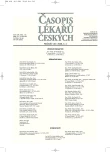Pulmonary Endarterectomy – The Surgical Treatment of Chronic Thromboembolic Pulmonary Hypertension
Authors:
J. Lindner; P. Jansa 1; J. Kunstýř 2; J. Bláha 2; T. Grus; F. Mlejnský; S. Heller 1; M. Škvařilová 1; D. Ambrož 1; J. Tošovský; M. Aschermann 1; A. Linhart 1; Křivánek J. Vítková I. 3 4; M. Stříteský 2
Authors‘ workplace:
II. chirurgická klinika kardiovaskulární chirurgie 1. LF UK a VFN, Praha
; II. interní klinika kardiologie a angiologie 1. LF UK a VFN, Praha
1; Klinika anestesiologie, resuscitace a intenzivní mediciny 1. LF UK a VFN, Praha
2; Radiodiagnostická klinika 1. LF UK a VFN, Praha
3; Ústav patologie 1. LF UK a VFN, Praha
4
Published in:
Čas. Lék. čes. 2006; 145: 307-312
Category:
Original Article
Overview
Background.
Chronic thromboembolic pulmonary hypertension (CTEPH) in indicated cases can be successfully treated by the endarterectomy of pulmonary arteries (PEA). Symptomatically not treated CTEPH has highly unfavourable prognosis. Five years survival of patients with mean pulmonary pressure over 50 mmHg is only 10%. PEA was not available in the Czech Republic till 2004, when PEA program was initiated it the Cardiocenter of the General teaching hospital in Prague in collaboration with leading clinics in that field (Prof. Mayer, University of Mainz, BRD).
Methods and results.
Up-to-date surgical technique, which in various modifications has been used at majority of clinics, was elaborated by Jamieson and Daily at University of California in San Diego. It is based on reverse endarterectomy performed during complete circulatory arrest with brain protection by deep hypothermia. Till September 2005 twelve patients were operated with zero mortality. In one patient a suture of atrial septum defect was necessary to perform along. Average time of the circulatory arrest was 45 minutes; duration of the extracorporal circulation was 334 minutes. Average duration of the operation was 450 minutes. Duration of the mechanical ventilation was in average 45.5 hours. After one month already haemodynamic parameters (mPA, CI, PVR) significantly improved or normalized and the average length in the test of six minutes walking increased by 132 meters.
Conclusion:
PEA represents a treatment method for patients with CTEPH and surgically accessible pulmonary artery obstruction. Centralized care of those patients is a rational necessity enabling to get maximum experience with complicated diagnostics and treatment of those patients. Multidisciplinary collaboration is the essential condition for the success of the program.
Key words:
Chronic thromboembolic pulmonary hypertension, pulmonary endarterectomy, circulatory arrest, deep hypothermia.
Labels
Addictology Allergology and clinical immunology Angiology Audiology Clinical biochemistry Dermatology & STDs Paediatric gastroenterology Paediatric surgery Paediatric cardiology Paediatric neurology Paediatric ENT Paediatric psychiatry Paediatric rheumatology Diabetology Pharmacy Vascular surgery Pain management Dental HygienistArticle was published in
Journal of Czech Physicians

Most read in this issue
- Purkynje Fibers of the Heart Conduction System – History and the Present Time
- Larva migrans cutanea
- Pulmonary Endarterectomy – The Surgical Treatment of Chronic Thromboembolic Pulmonary Hypertension
- Long-lasting Cardiostimulation in the Treatment of Heart Failure
